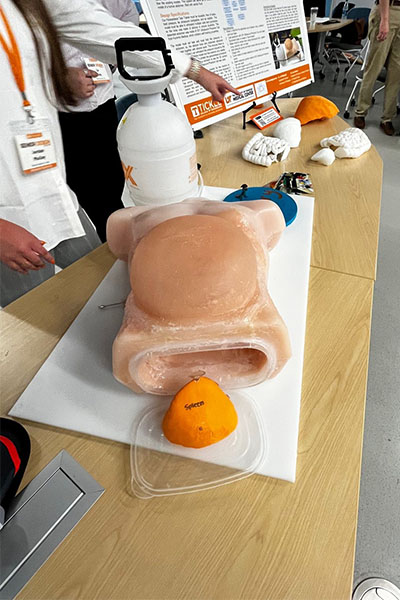There are certain medical procedures that healthcare workers perform so frequently they almost become like second nature. There are others, however, that aren’t as common and require some practice to keep the skills fresh.
Paracentesis is a procedure to remove extra fluid from the abdomen by using a needle and a catheter. The excess fluid is called ascites. Healthcare workers can perform a paracentesis to relieve pain or pressure, or to diagnose conditions that cause ascites, such as cirrhosis of the liver, portal hypertension, infection, organ failure, or cancer.
Leo Lamsen, an emergency physician at the University of Tennessee Medical Center and assistant professor at the UT Graduate School of Medicine, has a paracentesis task training model available to help medical students, resident physicians, and attending physicians practice the procedure.
The current training models can cost anywhere from $3,000-$10,000, and replacement inserts from $1,000-$5,000. Seeking a way to find a more cost-efficient model, Lamsen asked a senior design team from the Tickle College of Engineering to tackle the problem.
Recent biomedical engineering graduates Jordan Mullay, Liz Duty, and Palmer Baines created a training model that not only saves money, but better replicates the body of a patient. The model, which cost between $700-800, earned an honorable mention for Best Biomedical Engineering Prototype during this year’s Senior Design Showcase.
“It came out better than I thought it would,” Lamsen said. “I think they were able to design a model that offers something that isn’t available commercially. They did a great job.”
Lamsen wanted a training model that had a protruding abdomen filled with fluid to accurately display what patients look like when they arrive to be treated.
The senior design team ordered a mannequin on Amazon and developed the trainer using mold casting techniques and silicone that is reusable, durable, and doesn’t leak. They used a specific phantom gel for the stomach area that could be used for ultrasound so when healthcare workers insert the needle, they don’t accidentally hit one of the organs.
The organs were 3D printed and coated in the same material as the abdomen. The abdomen is filled with fluid through a pump, and the abdomen can be “self-healing” from the needle pokes by using a heat gun to seal the gel. 
The team went through a lot of trial and error to reach the final product. It was able to improvise and find better solutions than were part of the original design plan. The trainer provided more functionality than the current model Lamsen uses.
“The biggest lesson was being able to problem solve really quickly, and we used a lot of different things from our classes,” Mullay said. “For example, looking at the material properties of silicone that we used to make sure its durable or the mold casting technique, we wouldn’t have even thought of without ME 366. You could see all the different ideas from a lot of the different classes we’ve taken come together for this project.”
Mullay, Duty, and Baines delivered the paracentesis task training model to Lamsen in early May. They also provided all the files containing the photos, manufacturing plans, and testing results. Lamsen intends to use the training model this summer at UTMC and UTHSC for practice and see what other enhancements could be made in the future if needed.
Lamsen and MABE Associate Department Head and Director of Graduate Studies Jeffrey Reinbolt have also discussed having a similar senior design project next year to create a model for other medical procedures.
“It feels like all our hard work wasn’t for nothing. This project actually has meaning and what we did was useful and purposeful,” said Mullay, who is returning to UT in the fall for her master’s degree and already has been hired as a product development engineering at Helix Biotech in Knoxville. “It wasn’t just busy work. We actually accomplished something that was successful and can help others.”
Contact
Rhiannon Potkey (865-974-0683, rpotkey@utk.edu)
